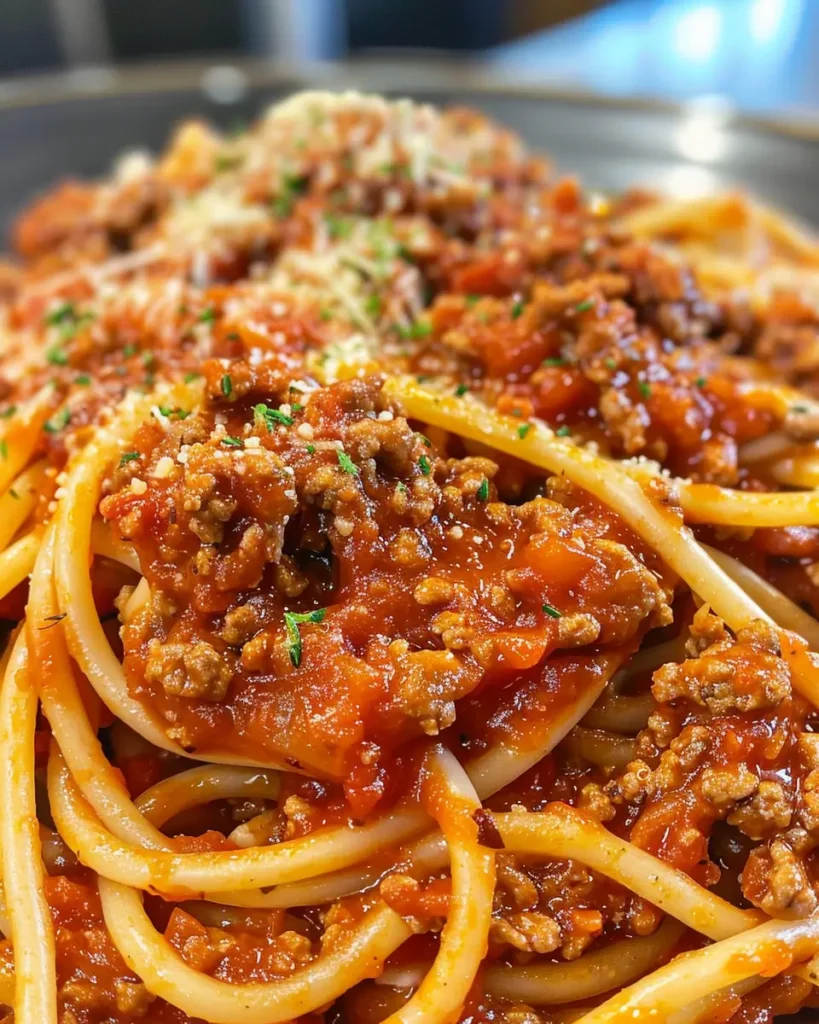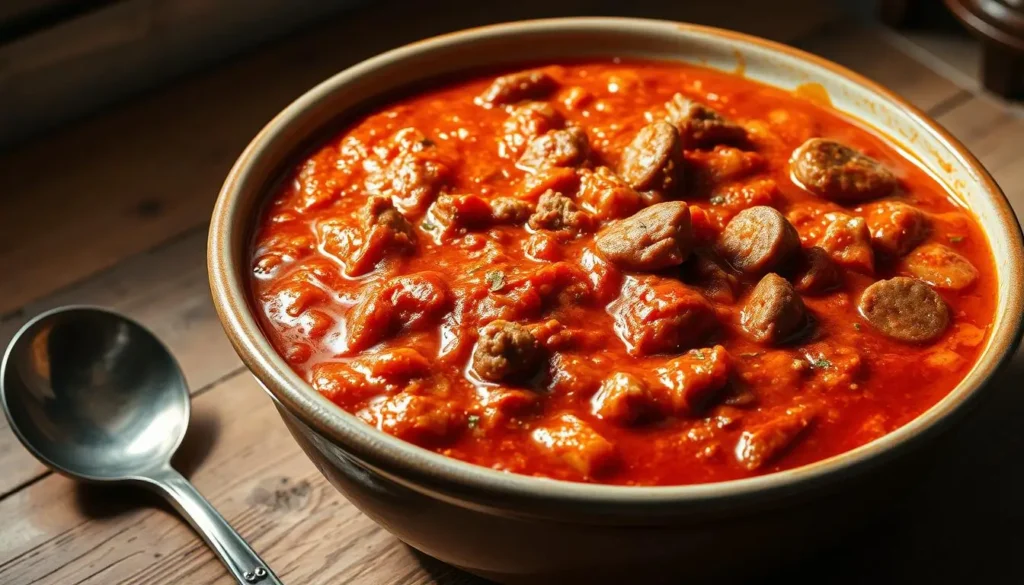Have you ever tried making spaghetti meat sauce at home? It’s a game-changer. This homemade sauce is more than just a topping; it’s a family favorite that brings everyone closer. You can make it with ingredients you probably have at home, creating a sauce that’s both rich and flavorful.

Creating homemade spaghetti meat sauce is more than cooking. It’s about sharing love and making memories. It turns a simple weeknight dinner into a special event. Whether you’re experienced in the kitchen or just starting out, making this sauce is a rewarding experience.
Key Takeaways
- Homemade spaghetti meat sauce is easy to make with pantry staples.
- It’s a versatile sauce that can be used in various dishes beyond spaghetti.
- The sauce can be customized with your favorite ingredients and flavors.
- It’s a great way to use up leftover ingredients and reduce food waste.
- Making homemade spaghetti meat sauce is a fun and rewarding cooking project.
The Secret to Perfect Homemade Spaghetti Meat Sauce
Making homemade spaghetti sauce from scratch can take your pasta dishes to new heights. You can tailor the flavor to your taste, making every meal more enjoyable.
Why Homemade Beats Store-Bought
Homemade spaghetti sauce is richer in flavor and free from preservatives. Choosing quality ingredients makes your sauce healthier and more delicious.
The Basic Principles of Great Sauce
A great spaghetti meat sauce needs a few key things. First, use top-notch ingredients. Second, cook the sauce slowly to bring out the flavors. Lastly, season it just right. Following these steps will help you make a spaghetti with meat sauce that everyone will love.
Mastering these basics will help you create an amazing homemade spaghetti sauce. It’s sure to impress your family and friends.
Essential Ingredients for Classic Spaghetti Meat Sauce
Making a tasty homemade spaghetti sauce recipe begins with knowing the key ingredients. The meat, tomatoes, and herbs you choose greatly affect the sauce’s flavor.
Choosing the Right Meat
The meat you pick is key for a hearty spaghetti with meat. You have many options, each bringing its own taste.
Ground Beef Options
Ground beef is a top pick for spaghetti meat sauce. You can choose from leaner or fattier options, like 80/20 or 85/15. Higher-fat ground beef makes the sauce more tender and juicy.
Adding Other Meats for Complexity
To make your sauce more complex, mix ground beef with other meats. Italian sausage, ground pork, or bacon can add layers of flavor and interest.
Tomato Options: Fresh vs. Canned
Tomatoes are the heart of any spaghetti sauce. You can use fresh or canned tomatoes. Canned tomatoes are easy and consistent, while fresh tomatoes bring a brighter taste.

Herbs and Seasonings That Make a Difference
Herbs and seasonings are essential for boosting your homemade spaghetti sauce’s flavor. Basil, oregano, and thyme are must-haves, along with garlic, onion, and bay leaves. Remember to season with salt and pepper to get the flavors right.
- Use fresh or dried herbs based on availability and preference.
- Adjust the amount of garlic and onion to suit your taste.
- Bay leaves add a subtle complexity; remove them before serving.
Kitchen Equipment You’ll Need
To make the perfect homemade spaghetti meat sauce, you’ll need the right kitchen equipment. The quality of your pots, pans, and utensils can greatly affect your sauce’s flavor and texture. Investing in good kitchen equipment is key to simplifying cooking and getting the best results.
Pots and Pans Recommendations
A heavy-bottomed pot is best for making homemade spaghetti meat sauce. It heats evenly. For pans, a large skillet is needed for browning meat and sautéing vegetables. A Dutch oven is also great for both browning and simmering.
Essential Utensils and Tools
Having the right utensils and tools is important. A wooden spoon is essential for stirring and tasting. A silicone spatula is great for scraping the pot’s sides. A good set of measuring cups and spoons helps you add the right seasoning.
Preparing Your Ingredients
Preparing your ingredients correctly is key to a great homemade spaghetti meat sauce. The quality and flavor of your sauce depend on how well you prepare the ingredients. It’s not just about chopping or browning; it’s about bringing out the best in each component.
Proper Vegetable Preparation
Vegetables are essential in a homemade spaghetti meat sauce, adding depth, texture, and flavor. Onions and garlic are staples, but other vegetables can also enhance the sauce. Start by selecting fresh, high-quality produce. For onions and garlic, dicing them appropriately is key to releasing their flavors.
Dicing Onions and Garlic
Dicing onions and garlic is a fundamental step in preparing your ingredients for a homemade spaghetti meat sauce. The size of the dice can affect the release of flavor during cooking. For onions, a medium dice is often ideal as it allows for a good balance between texture and flavor release. For garlic, mincing is usually the way to go to ensure it disperses well throughout the sauce.
Preparing Other Aromatics
Apart from onions and garlic, other aromatics like carrots, celery, or shallots can be used to add complexity to your sauce. These aromatics should be prepared in a way that they complement the overall flavor profile you’re aiming for. Sautéing them properly before adding other ingredients can make a significant difference.
Meat Preparation Techniques
The meat in your homemade spaghetti meat sauce is not just a filler; it’s a flavor powerhouse. Browning the meat properly is essential to develop that rich, meaty flavor that makes your sauce stand out. This involves cooking it at the right temperature and for the right amount of time to get that perfect caramelization.
Step-by-Step Cooking Process
Now that you’ve got your ingredients ready, it’s time to start cooking. We’ll guide you through the steps to make a rich, flavorful homemade spaghetti meat sauce. Each step is important to create a sauce that’s both tasty and authentic.
Building the Flavor Base
The base of a great spaghetti meat sauce is all about flavor. Start by sautéing onions, garlic, and sometimes carrots or celery in olive oil. Choose a good quality olive oil to boost the sauce’s flavor. Cook these over medium heat, stirring now and then, until they’re soft and clear.
Adding a pinch of salt helps bring out the sweetness of the onions and other aromatics. Let them cook slowly. This way, they caramelize, adding a sweet and savory taste to your sauce.
Adding and Cooking the Meat
Now, add the meat to your flavor base. Ground beef is classic, but you can also use ground pork or a mix. Browning the meat is key; it adds a rich flavor. Break the meat into small pieces as it cooks to brown evenly.
Cook the meat until it’s fully browned, stirring now and then. This should take about 5-7 minutes. If using wine, deglaze the pan with a small amount. This adds depth to the sauce.
Incorporating Tomatoes and Simmering
Once the meat is browned, add the tomatoes. Use canned crushed tomatoes or fresh, peeled, and crushed tomatoes. Canned tomatoes are easy and consistent. Mix the tomatoes with the meat, then add herbs or seasonings.
Simmer the sauce slowly, uncovered, for at least 30 minutes, stirring now and then. This slow cooking melds the flavors and thickens the sauce. You’ll end up with a rich, hearty homemade spaghetti sauce that’s easy to make and delicious.
The Art of Seasoning Your Spaghetti Meat Sauce
To make your homemade spaghetti sauce recipe better, mastering seasoning is key. Seasoning is a critical step. It can turn your spaghetti with meat sauce into a true culinary delight.
When to Add Different Herbs and Spices
Knowing when to add herbs and spices is important for a deep flavor. Add harder herbs like bay leaves and rosemary early. Delicate herbs like basil are best added towards the end.
Balancing Flavors: Sweet, Savory, and Acidic
Balancing your sauce’s flavors is an art. It needs attention to sweet, savory, and acidic notes. Key elements include:
- Sweetness from carrots or a hint of sugar
- Savory flavors from meat and tomatoes
- Acidity from tomatoes or wine
Using Sugar to Cut Acidity
A pinch of sugar can balance acidity in your sauce. This makes the flavor smoother. It’s very useful with canned tomatoes, which can be acidic.
Adding Umami Depth
Umami flavor can be boosted by adding mushrooms, anchovies, or soy sauce or miso paste. This adds depth to your homemade spaghetti sauce recipe.
Simmering Secrets: How Long and Why It Matters
Simmering your spaghetti sauce is more than just cooking. It’s about bringing out the flavor and texture. This step turns a good sauce into a great one, making your homemade spaghetti sauce stand out.
The Science Behind Slow Simmering
Slow simmering cooks the sauce at a low temperature for a long time. This lets the flavors blend, the meat get tender, and the sauce thicken. It’s a simple yet effective way to make your spaghetti sauce richer and more complex.
Key benefits of slow simmering include:
- Flavor enhancement
- Meat tenderization
- Thickening of the sauce
How to Tell When Your Sauce Is Ready
Figuring out when your spaghetti sauce is ready can be tricky. Look for signs like a thickened sauce and balanced flavors. Taste it; if it’s too acidic or bland, it needs more simmering.
A good rule of thumb is to simmer your sauce for at least 30 minutes to an hour. But the longer it simmers, the better it gets, as long as it doesn’t burn or stick to the pan.
| Simmering Time | Sauce Characteristics |
|---|---|
| 30 minutes | Basic flavor development, slightly thickened |
| 1 hour | Rich flavor, thicker consistency |
| 2+ hours | Complex flavor profile, thick and rich texture |
Traditional Spaghetti Meat Sauce Variations
There are many exciting variations of the traditional spaghetti meat sauce. You can try these different versions to spice up your homemade sauce.
Regional Italian Variations
Italy is famous for its diverse culinary styles. The Bolognese and Sicilian regions have their own unique takes on the classic spaghetti meat sauce.
Bolognese Style
The Bolognese style is known for its rich, meaty sauce. It’s made with ground beef, pork, or a mix of both. The sauce is slow-cooked with tomatoes, onions, carrots, celery, and sometimes red wine.
Sicilian Influence
Sicilian cuisine adds its own special flavor to the spaghetti meat sauce. It often includes eggplant, garlic, and sometimes sardines or anchovies for a unique taste.
American Adaptations
American cuisine has made its own changes to the traditional Italian spaghetti meat sauce. It often mixes local flavors and ingredients. Some common changes include adding sugar to balance the acidity or using ground turkey or chicken instead of beef.
Dietary Modifications
There are ways to modify the traditional spaghetti meat sauce for dietary needs. Two popular changes are gluten-free and low-carb versions.
Gluten-Free Options
To make a gluten-free spaghetti meat sauce, replace certain ingredients that may have gluten. Use gluten-free alternatives and always check labels for compliance.
Low-Carb Alternatives
Low-carb alternatives involve reducing or removing high-carb ingredients like tomatoes. Use tomato sauce with no added sugars. Serve the meat sauce over zucchini noodles or shirataki noodles for a lower-carb meal.
Troubleshooting Common Sauce Problems
Don’t let a less-than-perfect spaghetti meat sauce ruin your dinner plans. Here are some quick fixes for common issues. Making a great homemade spaghetti sauce is easy, but sometimes things don’t go as planned. Whether your sauce is too watery, too acidic, or just bland, we’ve got the solutions you need to save the day.
Fixing a Watery Sauce
A watery spaghetti meat sauce can be disappointing, but it’s an easy fix. Try simmering it for a longer period to reduce the liquid. Or, add a little tomato paste to thicken it without changing the flavor much.
Another option is to mix a small amount of cornstarch or flour with water. Make a slurry, then stir it into the sauce and simmer until it thickens.
Remedies for Too Much Acidity
If your spaghetti sauce tastes too acidic, there are a few remedies you can try. Adding a pinch of sugar can help balance out the acidity. You can also try adding a dairy product like milk or cream, which not only reduces acidity but also enriches the sauce.
For a more nuanced approach, consider adding a grated carrot or a bit of baking soda. But be cautious with the latter as it can affect the flavor if overdone.
Solutions for Bland Flavor
A bland spaghetti meat sauce can be a letdown, but it’s easily rectified. First, check your seasoning and adjust as needed. Adding more herbs and spices can make a big difference.
Consider adding a teaspoon of mushroom extract to enhance the umami flavor. Or, sauté some mushrooms with your onions and garlic at the start. You can also try adding a bit more salt or using salted ingredients to bring out the other flavors.
Storing and Reheating Your Homemade Sauce
To enjoy your homemade spaghetti sauce for a long time, knowing how to store and reheat it is important. The right storage and reheating methods help keep the sauce’s quality. You can enjoy your homemade spaghetti sauce recipe for days or weeks if you follow the right steps.
Refrigeration Guidelines
First, cool the sauce to room temperature before refrigerating it to stop bacteria from growing. Use airtight containers to keep it fresh. Your sauce can stay good in the fridge for 3 to 5 days.
Freezing Methods for Long-Term Storage
Freezing is great for keeping the sauce for a long time. Put it in airtight containers or freezer bags, squeezing out air before sealing. Frozen sauce can last months. To thaw, leave it in the fridge overnight or thaw quickly in cold water.
| Storage Method | Duration | Notes |
|---|---|---|
| Refrigeration | 3-5 days | Cool to room temperature before storing |
| Freezing | Several months | Use airtight containers or freezer bags |
Best Practices for Reheating
Reheat the sauce slowly over low heat, stirring now and then. You can also use the microwave, stirring every 30 seconds until it’s hot. For more ideas, try this creamy tomato ricotta pasta recipe.
Serving Your Spaghetti with Meat Sauce
Now that you’ve made homemade spaghetti meat sauce, it’s time to serve it. Serving your spaghetti with a tasty sauce spaghetti can change your meal. Whether you want spaghetti recipes easy or ways to make your meal better, the right serving ideas matter.
Pasta Pairing Recommendations
Choosing the right pasta for your meat sauce is key. While spaghetti is classic, linguine or fettuccine also work well. For a true Italian taste, try spaghetti or buccatini. If you want spaghetti recipes easy to change, use pasta shapes that hold sauce well.
Garnishing Ideas
Garnishing your dish adds elegance and freshness. Sprinkle Parmesan cheese over your spaghetti. Add parsley or basil for color and flavor. A drizzle of good olive oil can also enhance your sauce spaghetti.
Complementary Side Dishes
To make your spaghetti with meat sauce a full meal, add side dishes. A simple green salad or garlic bread contrasts the sauce’s richness. Roasted veggies like broccoli or asparagus add health and flavor.
Conclusion
Now you know how to make homemade spaghetti meat sauce. This guide has given you the tools to create a sauce that’s loved by all. It’s time to make it in your kitchen.
Choosing the right ingredients and cooking them with care makes a big difference. Your homemade sauce will taste better than store-bought ones. It’s perfect for any meal, whether it’s a weeknight dinner or a special event.
Get your ingredients ready and start cooking. With this guide, you’ll soon be making delicious spaghetti meat sauce. Enjoy every bite of your homemade masterpiece.
FAQ
What is the best type of meat to use in homemade spaghetti meat sauce?
Ground beef is a top pick. But, you can also use ground pork or a mix of beef and pork. For a leaner choice, try ground turkey or chicken.
Can I use canned tomatoes for homemade spaghetti meat sauce?
Yes, canned tomatoes are easy and tasty. Choose San Marzano or other high-quality canned tomatoes for the best taste.
How long should I simmer my spaghetti meat sauce?
Simmer for at least 30 minutes to an hour. Longer simmering makes the sauce thicker and more flavorful.
What are some common mistakes to avoid when making homemade spaghetti meat sauce?
Avoid not browning the meat well, not simmering long enough, and not seasoning right.
Can I make homemade spaghetti meat sauce in advance?
Yes, you can make it ahead and store it in the fridge or freezer. It’s great for saving time on busy days.
How do I store leftover spaghetti with meat sauce?
Keep leftovers in airtight containers in the fridge for up to three days. Or freeze for up to three months.
What are some variations of spaghetti meat sauce I can try?
Try different Italian styles, American twists, or make it vegetarian or vegan.
Can I use homemade spaghetti meat sauce for other dishes beside spaghetti?
Absolutely. Use it as a topping for other pasta, a lasagna or cannelloni sauce, or as a dipping sauce.
How can I thicken a watery spaghetti meat sauce?
Thicken by simmering longer, adding tomato paste, or using cornstarch or flour.
What are some good pasta shapes to pair with spaghetti meat sauce?
Spaghetti is classic, but try linguine or fettuccine for a similar feel. Short shapes like penne or rigatoni also work well.

Spaghetti Meat Sauce
Ingredients
Meat Ingredients
- 1 lb Ground Beef You can choose lean or fatty ground beef, such as 80/20 or 85/15.
- 1 lb Italian Sausage Optional, for additional flavor complexity.
Tomato Ingredients
- 28 oz Canned Crushed Tomatoes You can also use fresh, peeled, and crushed tomatoes.
Vegetables
- 1 medium Onion, diced Adds flavor; use a medium dice for even cooking.
- 3 cloves Garlic, minced Can adjust the amount according to personal taste.
- 1 medium Carrot, diced Optional, for added sweetness.
Herbs and Seasonings
- 1 tsp Dried Basil Can substitute with fresh basil if available.
- 1 tsp Dried Oregano Adjust to taste.
- 1 bay leaf Bay Leaf Remove before serving.
- Salt and Pepper to taste Salt and Pepper Important for balancing flavors.
Others
- 2 tbsp Olive Oil For sautéing vegetables.
- 1 tbsp Sugar Optional, to cut acidity.
Instructions
Preparation
- Dice the onion and carrot, and mince the garlic.
- In a heavy-bottomed pot, heat the olive oil over medium heat.
Cooking
- Sauté the onions and garlic until soft and clear, about 5 minutes.
- Add the ground beef and sausage to the pot, breaking it apart, and brown for about 7-10 minutes.
- Stir in the diced carrots and season with salt and pepper.
- Add the canned crushed tomatoes and stir well. If using, add sugar to balance the acidity.
- Add the dried herbs (basil, oregano) and the bay leaf, stirring to combine.
- Bring the sauce to a simmer and reduce heat to low. Allow to simmer uncovered for at least 30 minutes, stirring occasionally.
Finalizing the Sauce
- Taste the sauce and adjust seasoning if necessary, adding more herbs or salt to taste.
- Remove bay leaf before serving.







